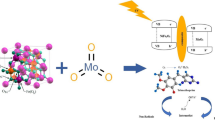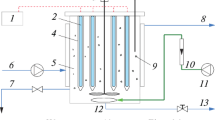Abstract
The present study investigated the degradation of trimethoprim using Eosin Y-sensitized ZnFe2O4-g-C3N4 photocatalyst under natural sunlight using a parabolic trough reactor. The photocatalyst performance was optimized for three independent variables: pollutant dosage (10–25 mg/l), catalyst dose (0.4–1.2 g/l), and solution pH (4–10). The central composite design (CCD) was used to generate the design matrix and the response surface for degradation and total organic carbon (TOC) removal as the responses. Multiple regression techniques for each response generated two quadratic polynomial models. The coefficient of determination (R2) for trimethoprim degradation and TOC removal was 0.99 and 0.96, respectively, and these models could explain the variability in response surface. The analysis of variance (ANOVA) revealed that the initial pollutant dose and catalyst dose were most significant (p < 0.05) in contributing to both degradation and TOC removal. The optimum parameters obtained by desirability function for pollutant concentration, pH, and catalyst concentration were 10 mg/l, 7.19, and 0.72 g/l. This yielded an optimum degradation and TOC removal of 89.52% and 49.12%, respectively. Validation studies using optimized conditions for single-factor experiments had negligible variation from the predicted values, with actual degradation and TOC removal being 87.02% and 46.33%, respectively. Considering the good predictability and validity of the models, Response Surface Methodology is a potential mathematical tool for modeling the photodegradation of different antibiotics in aquatic environments.




Similar content being viewed by others
Data availability
Data supporting this manuscript is available on request from the corresponding author.
References
González B, Trujillano R, Vicente MA, Rives V, Korili SA, Gil A (2019) Photocatalytic degradation of trimethoprim on doped Ti-pillared montmorillonite. Appl Clay Sci 167:43–49. https://doi.org/10.1016/j.clay.2018.10.006
Mpatani FM, Aryee AA, Kani AN, Han R, Li Z, Dovi E, Qu L (2021) A review of treatment techniques applied for selective removal of emerging pollutant-trimethoprim from aqueous systems. J Clean Prod 308:127359. https://doi.org/10.1016/j.jclepro.2021.127359
Li M, Chen M, Lee SLJ, Lin S (2023) Facile fabrication of a 2D/2D CoFe-LDH/g-C3N4 nanocomposite with enhanced photocatalytic tetracycline degradation. Environ Sci Pollut Res 30:4709–4720. https://doi.org/10.1007/s11356-022-22554-3
Deng Y, Tang L, Zeng G, Wang J, Zhou Y, Wang J, Tang J, Wang L, Feng C (2018) Facile fabrication of mediator-free Z-scheme photocatalyst of phosphorous-doped ultrathin graphitic carbon nitride nanosheets and bismuth vanadate composites with enhanced tetracycline degradation under visible light. J Colloid Interface Sci 509:219–234. https://doi.org/10.1016/j.jcis.2017.09.016
Abeer Mohammed AB, Abd Elhamid MM, Khalil MKM, Ali AS, Abbas RN (2022) The potential activity of biosynthesized silver nanoparticles of Pseudomonas aeruginosa as an antibacterial agent against multidrug-resistant isolates from intensive care unit and anticancer agent. Environ Sci Eur 34:109. https://doi.org/10.1186/s12302-022-00684-2
Berkani M, Kadmi Y, Bouchareb MK, Bouhelassa M, Bouzaza A (2020) Combinatıon of a Box-Behnken design technique with response surface methodology for optimization of the photocatalytic mineralization of C.I. Basic Red 46 dye from aqueous solution. Arab J Chem 13:8338–8346. https://doi.org/10.1016/j.arabjc.2020.05.013
Zhao Y, Qin H, Wang Z, Wang H, He Y, Tian Q, Luo Q, Xu P (2022) Facile synthesis of cadmium—doped graphite carbon nitride for photocatalytic degradation of tetracycline under visible light irradiation. Environ Sci Pollut Res. https://doi.org/10.1007/s11356-022-21051-x
Patel SB, Tripathi A, Vyas AP (2021) Environmental nanotechnology, monitoring & management recent development in the structural modification of graphitic carbon nitride for sustainable photocatalysis: advances, challenges and opportunities. Environ Nanotechnol Monit Manag 16:100589. https://doi.org/10.1016/j.enmm.2021.100589
Ismael M (2020) A review on graphitic carbon nitride (g-C3N4) based nanocomposites: synthesis, categories, and their application in photocatalysis. J Alloys Compds 846:156446. https://doi.org/10.1016/j.jallcom.2020.156446
Darkwah WK, Ao Y (2018) Mini review on the structure and properties (photocatalysis), and preparation techniques of graphitic carbon nitride nano-based particle, and its applications. Nanoscale Res Lett. https://doi.org/10.1186/s11671-018-2702-3
Huong T, Hieu M, Thu T, Chu H, Myung Y, Hoon S, Mapari MG, Taeyoung K (2023) Enhanced photodegradation of tetracycline in wastewater and conversion of CO2 by solar light assisted ZnO/g-C3N4. Environ Res 217:114825. https://doi.org/10.1016/j.envres.2022.114825
Chen L, Ma W, Dai J, Zhao J, Li C, Yan Y (2016) Facile synthesis of highly efficient graphitic-C3N4/ZnFe2O4 heterostructures enhanced visible-light photocatalysis for spiramycin degradation. J Photochem Photobiol A Chem 328:24–32. https://doi.org/10.1016/j.jphotochem.2016.04.026
Rong X, Liu S, **e M, Liu Z, Wu Z, Zhou X, Qiu X, Wei J (2020) N2 photofixation by Z-scheme single-layer g-C3N4/ZnFe2O4 for cleaner ammonia production. Mater Res Bull. https://doi.org/10.1016/j.materresbull.2020.110853
Sonu SS, Dutta V, Raizada P, Hosseini-Bandegharaei A, Thakur V, Nguyen VH, Vanle Q, Singh P (2021) An overview of heterojunctioned ZnFe2O4 photocatalyst for enhanced oxidative water purification. J Environ Chem Eng 9:105812. https://doi.org/10.1016/j.jece.2021.105812
Palanivel B, Jayaraman V, Ayyappan C, Alagiri M (2019) Magnetic binary metal oxide intercalated g-C3N4: energy band tuned p–n heterojunction towards Z-scheme photo-Fenton phenol reduction and mixed dye degradation. J Water Pro Eng. https://doi.org/10.1016/j.jwpe.2019.100968
Vidyasagar D, Ghugal SG, Kulkarni A, Shende AG, Umare SS, Sasikala R (2018) Microwave assisted: in situ decoration of a g-C3N4 surface with CdCO3 nanoparticles for visible light driven photocatalysis. New J Chem 42:6322–6331. https://doi.org/10.1039/c8nj00444g
Zhang Y, Sivakumar M, Yang S, Enever K, Ramezanianpour M (2018) Application of solar energy in water treatment processes: a review. Desalination 428:116–145. https://doi.org/10.1016/j.desal.2017.11.020
Mecha AC, Onyango MS, Ochieng A, Jamil TS, Fourie CJS, Momba MNB, Mecha AC, Onyango MS, Ochieng A, Jamil TS (2016) UV and solar light photocatalytic removal of organic contaminants in municipal wastewater. Sep Sci Technol 51(10):1765–1778. https://doi.org/10.1080/01496395.2016.1178290
Fendrich MA, Quaranta A, Orlandi M, Bettonte M, Miotello A (2019) Solar concentration for wastewaters remediation: a review of materials and technologies. Appl sci. https://doi.org/10.3390/app9010118
Diaz-angulo J, Arce-sarria A, Mueses M, Hernandez-ramirez A, Machuca-martinez F (2019) Analysis of two dye-sensitized methods for improving the sunlight absorption of TiO2 using CPC photoreactor at pilot scale. Mater Sci Semicond Process 103:104640. https://doi.org/10.1016/j.mssp.2019.104640
Zhang N, Wen L, Yan J, Liu Y (2020) Dye-sensitized graphitic carbon nitride (g-C3N4) for photocatalysis: a brief review. Chem Pap 74:389–406. https://doi.org/10.1007/s11696-019-00929-0
Das KK, Patnaik S, Mansingh S, Behera A, Mohanty A, Acharya C, Parida KM (2020) Enhanced photocatalytic activities of polypyrrole sensitized zinc ferrite/graphitic carbon nitride n–n heterojunction towards ciprofloxacin degradation, hydrogen evolution and antibacterial studies. J Colloid Interface Sci 561:551–567. https://doi.org/10.1016/j.jcis.2019.11.030
Palani G, Apsari R, Hanafiah MM, Venkateswarlu K, Lakkaboyana SK, Kannan K, Shivanna AT, Idris AM, Yadav CH (2022) Metal-doped graphitic carbon nitride nanomaterials for photocatalytic environmental applications—a review. Nanomaterials 12:1–14. https://doi.org/10.3390/nano12101754
Marizcal-Barba A, Sanchez-Burgos JA, Zamora-Gasga V, Perez Larios A (2022) Study of the response surface in the photocatalytic degradation of acetaminophen using TiO2. Photochem 2:225–236. https://doi.org/10.3390/photochem2010017
Khoshnamvand N, Kord Mostafapour F, Mohammadi A, Faraji M (2018) Response surface methodology (RSM) modeling to improve removal of ciprofloxacin from aqueous solutions in photocatalytic process using copper oxide nanoparticles (CuO/UV). AMB Express 8:1–9. https://doi.org/10.1186/s13568-018-0579-2
Zare MH, Mehrabani-Zeinabad A (2022) Photocatalytic activity of ZrO2/TiO2/Fe3O4 ternary nanocomposite for the degradation of naproxen: characterization and optimization using response surface methodology. Sci Rep. https://doi.org/10.1038/s41598-022-14676-y
Rakshitha R, Rajesh C, Gurupadayya B, Haridas S, Devi K (2023) A response surface modeling and optimization of photocatalytic degradation of 2, 4-dichlorophenol in water using hierarchical nano-assemblages ofCuBi2O4 particles. Environ Sci Pollut Res. https://doi.org/10.1007/s11356-023-27774-9
Attarikhasraghi N, Zare K, Mehrizad A, Modirshahla N, Behnajady MA (2021) Achieving the enhanced photocatalytic degradation of ceftriaxone sodium using CdS-g-C3N4 nanocomposite under visible light irradiation: RSM modeling and optimization. J Inorg Organomet Polym Mater. https://doi.org/10.1007/s10904-021-01967-6
Abid MF, Abdulla ON, Kadhim AF (2019) Study on removal of phenol from synthetic wastewater using solar photo catalytic reactor. J King Saud Univ-Eng Sci 31:131–139. https://doi.org/10.1016/j.jksues.2017.03.002
Zhang D, Wang F, Cao S, Duan X (2018) Investigation on enhanced photocatalytic degradation of bisphenol a with bismuth oxyiodide catalyst using response surface methodology. RSC Adv 8:5967–5975. https://doi.org/10.1039/c7ra13460f
Samuel HM, M’Arimi MM, Achisa Mecha C (2024) Synthesis, characterization, and photocatalytic performance of ZnFe2O4-g-C3N4 composites for tetracycline removal from contaminated water. J Nanotechnol 2024:1–15. https://doi.org/10.1155/2024/6687926
Lin YP, Mehrvar M (2018) Photocatalytic treatment of an actual confectionery wastewater using Ag/TiO2/Fe2O3: optimization of photocatalytic reactions using surface response methodology. Catalysts 8:1–17. https://doi.org/10.3390/catal8100409
Yin H, Cao Y, Fan T, Li P, Liu X (2021) Construction of AgBr/β-Ag2WO4/g-C3N4 ternary composites with dual Z-scheme band alignment for efficient organic pollutants removal. Sep Purif Technol 272:118251. https://doi.org/10.1016/j.seppur.2020.118251
Ljubas D, Juretić H, Badrov A, Biošić M, Babić S (2023) Photocatalytic degradation of pharmaceutical trimethoprim in aqueous solution over nanostructured TiO2 film irradiated with simulated solar radiation. Appl Sci. https://doi.org/10.3390/app13095681
Saeed H, Nadeem N, Zahid M, Yaseen M, Noreen S, Jilani A, Shahid I (2021) Mixed metal ferrite (Mn0.6Zn0.4Fe2O4) intercalated g-C3N4nanocomposite: efficient sunlight driven photocatalyst for methylene blue degradation. Nanotechnology. https://doi.org/10.1088/1361-6528/ac2847
Dai Z, Zhen Y, Sun Y, Li L, Ding D (2021) ZnFe2O4/g-C3N4 S-scheme photocatalyst with enhanced adsorption and photocatalytic activity for uranium(VI) removal. Chem Eng J. https://doi.org/10.1016/j.cej.2021.129002
Samy M, Ibrahim MG, Gar Alalm M, Fujii M, Ookawara S, Ohno T (2020) Photocatalytic degradation of trimethoprim using S-TiO2 and Ru/WO3/ZrO2 immobilized on reusable fixed plates. J Water Pro Eng 33:3–10. https://doi.org/10.1016/j.jwpe.2019.101023
Hosseini O, Zare-shahabadi V, Ghaedi M, Azqhandi MHA (2022) Experimental design, RSM and ANN modeling of tetracycline photocatalytic degradation using LDH @ CN. J Environ Chem Eng 10:108345. https://doi.org/10.1016/j.jece.2022.108345
Shu HM, **e JM, Xu H, Li HM, Xu YG, Gu Z (2010) Characterization and photocatalytic activity of ZnO/AgNbO3. Wuji Cailiao Xuebao/Journal Inorg Mater 25:935–941. https://doi.org/10.3724/SP.J.1077.2010.00935
Pham TH, Jung SH, Kim TY (2021) Enhanced photodegradation of toxic volatile organic pollutants using Ni-doped graphitic carbon nitride under natural solar light. Sol Energy 224:18–26. https://doi.org/10.1016/j.solener.2021.05.087
Zhou W, Yang B, Liu G, Xu C, Ji Q, **ang W, Sun D (2022) Perylene diimide supermolecule (PDI) as a novel and highly efficient cocatalyst for photocatalytic degradation of tetracycline in water : a case study of PDI decorated graphitic carbon nitride/bismuth tungstate. J Colloid Interface Sci 615:849–864. https://doi.org/10.1016/j.jcis.2022.02.003
Le Minh Tri N, Kim J, Giang BL, Al Tahtamouni TM, Huong PT, Lee C, Viet NM, Quang Trung D (2019) Ag-doped graphitic carbon nitride photocatalyst with remarkably enhanced photocatalytic activity towards antibiotic in hospital wastewater under solar light. J Ind Eng Chem 80:597–605. https://doi.org/10.1016/j.jiec.2019.08.037
Minh N, Quang D, Long B, Le N, Tri M, Thao P (2019) Noble metal-doped graphitic carbon nitride photocatalyst for enhancement photocatalytic decomposition of antibiotic pollutant in wastewater under visible light. J Water Process Eng 32:100954. https://doi.org/10.1016/j.jwpe.2019.100954
Acknowledgements
Funding for this research work was provided by the Kenya National Research Fund [Grant number 2/MMC/825] under the Sustainable Technologies for Potable Water Treatment programme. The authors are also grateful to Paul Kemboi, the laboratory technician at Chemical & Process Engineering Moi University. His assistance in the lab was helpful in materializing this study.
Author information
Authors and Affiliations
Contributions
Humphrey Mutuma: Conceptualization, methodology, investigation and wrote the manuscript; Cleophas Achisa: Designed the experiments, conceptualization, methodology, investigation; Milton M’Arimi: conceptualization, investigation, and visualization.
Corresponding author
Ethics declarations
Conflict of interest
The authors certify they have no affiliation to an organization or any financial interest in the subject matter or result discussed in this manuscript.
Additional information
Publisher's Note
Springer Nature remains neutral with regard to jurisdictional claims in published maps and institutional affiliations.
Supplementary Information
Below is the link to the electronic supplementary material.
Rights and permissions
Springer Nature or its licensor (e.g. a society or other partner) holds exclusive rights to this article under a publishing agreement with the author(s) or other rightsholder(s); author self-archiving of the accepted manuscript version of this article is solely governed by the terms of such publishing agreement and applicable law.
About this article
Cite this article
Samuel, H.M., Mecha, C.A. & M’Arimi, M.M. Response surface methodology optimization of trimethoprim degradation in wastewater using Eosin-Y sensitized 25%ZnFe2O4-g-C3N4 composite under natural sunlight. Reac Kinet Mech Cat 137, 2415–2430 (2024). https://doi.org/10.1007/s11144-024-02650-w
Received:
Accepted:
Published:
Issue Date:
DOI: https://doi.org/10.1007/s11144-024-02650-w




